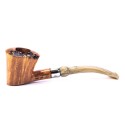Tobacco Pipe Mouthpieces: The Types
The tobacco pipe mouthpiece constitutes an essential part of the pipe, because through only it is possible to "pull" smoke.
There are various types: extendable, with additional cannula, oval, round, square or rectangular cross-section.
The exit hole can be either a round hole, or a slot of oval or rectangular shape, so as to widen the smoke exit, preventing it from concentrating on one spot on the tongue.
As for the materials used, they have changed over time to adapt to smokers' needs and improve smoking performance.
Let's discover together the various types of pipe mouthpieces!
Wooden mouthpieces
Wooden mouthpieces began to be used in the 19th century, being applied in plaster and earthenware pipes, proving to be an inexpensive alternative to amber mouthpieces.
The woods used were cherry or morello cherry.
Amber mouthpieces
Amber is a much sought-after material in mouthpieces because of its special coloring, which encompasses all shades of yellow.
At one time it was certainly more common in tobacco pipes, while today it is little used because it is increasingly scarce to find.
Its fragility, equivalent to that of glass, is certainly not a point in its favor.
Amber was widely used in meerschaum pipes, to be gradually replaced by cheaper and more durable materials.
Horn mouthpieces
At one time, before the advent of ebonite and methacrylate, mouthpieces were mostly made from ox horn.
This is a material with advantages, but also disadvantages.
Aesthetically, they were highly valued for their color and its variegation when this was still new. Its problem was its great fragility and that, with smoking, it tended to take on less pleasant colors.
To this must be added that horn, being an organic material, is porous, so cracks originate with time.
At present, tobacco pipes with horn mouthpieces are still produced, but with the addition of a methacrylate insert as a mouthpiece tooth.
Ebonite mouthpieces
Ebonite began to be used as an alternative to horn, and then underwent technical improvements, ending up being, to this day, one of the most widely used materials for making mouthpieces.
Ebonite is derived from natural rubber, from Malaysia, to which sulfur is added, creating a mixture then poured into aluminum or steel molds.
Through vulcanization in an autoclave at 180°, a rough mouthpiece is obtained, then delivered to craftsmen, who finish it and mount it on the briar head.
Admirers of ebonite consider it more pleasant to bite into than methacrylate, being more elastic, although one should never go overboard in biting it because one risks scratching it.
Another merit is the possibility of making the mouthpiece thinner, avoiding excess salivation.
The only downside is related to progressive yellowing with smoking, which can be overcome by lightly abrading the surface so as to restore its luster.
To remedy this problem, modern pipe companies have decreased the amount of sulfur used in production, as it is the main culprit in yellowing.
When treated with pastes and subjected to waxing, ebonite becomes shiny and lustrous.
Methacrylate mouthpieces
The advent of methacrylate was certainly revolutionary, introduced early after World War II by Castello, at the time led by its founder Carlo Scotti.
The great possibilities in terms of customization made it the main material used in the production of handmade pipes.
Methacrylate is harder to work with than ebonite, but it remains intact indefinitely, also proving resistant to the action of ultraviolet rays, but also to more aggressive saliva, which, in the case of ebonite, tends to yellow the mouthpiece.
Advice for mouthpieces
It is very important to avoid disassembling the mouthpiece while the tobacco pipe is still hot, because you risk breaking it irreparably, both in the case of ebonite and methacrylate, as they tend to expand with overheating.






